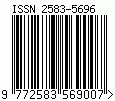Survey On Object Detection, Face Tracking, Digital Mapping and Lane Following For Remotely Piloted Aerial Systems (RPAS)
DOI:
https://doi.org/10.5281/zenodo.7900522Keywords:
Remotely Piloted Aerial systems, remote sensing application, Object detection, Face detectionAbstract
Remotely Piloted Aerial Systems (RPAS) for remote sensing, a significant way of obtaining geographic data, has benefits like real-time, adaptability, high-resolution, cost-effectiveness, etc., and it can acquire data in risky environments without jeopardizing flight crews. It has great potential and a promising future since RPAS remote sensing is a powerful companion to airborne and spaceborne remote sensing. This work provides a comprehensive view of recent advancements in the field of Remotely Piloted Aerial Systems (RPAS) with machine learning features. The focus is on some specific areas: Face tracking, Object Detection, Surveillance. The paper describes the methods and algorithms used for these applications, discusses their performance and accuracy, and highlights the challenges faced in the implementation of such systems. The paper also provides an overview of the various platforms and tools used for the development of these systems, including hardware and software components. The review concludes by highlighting the future directions for research and development in this field.
References
Aibin, M., Aldiab, M., Bhavsar, R., Lodhra, J., Reyes, M., Rezaeian, F., Saczuk, E., Taer, M., & Taer, M. (2021). Survey of RPAS Autonomous Control Systems Using Artificial Intelligence. IEEE Access, 9, 167580–167591. https://doi.org/10.1109/access.2021.3136226
Kim, T. Y., & Kim, J. N. (2020). Implementation of unmanned aerial system for surveillance mode. International Conference on Information and Communication Technology Convergence. https://doi.org/10.1109/ictc49870.2020.9289181
Tayara, H., Soo, K. G., & Lu, N. (2018). Vehicle Detection and Counting in High-Resolution Aerial Images Using Convolutional Regression Neural Network. IEEE Access, 6, 2220–2230. https://doi.org/10.1109/access.2017.2782260
Sambolek, S., & Ivašić-Kos, M. (2021). Automatic Person Detection in Search and Rescue Operations Using Deep CNN Detectors. IEEE Access, 9, 37905–37922. https://doi.org/10.1109/access.2021.3063681
Saetchnikov, I., Tcherniavskaia, E. A., & Skakun, V. S. (2021b). Object Detection for Unmanned Aerial Vehicle Camera via Convolutional Neural Networks. IEEE Journal on Miniaturization for Air and Space Systems, 2(2), 98–103. https://doi.org/10.1109/jmass.2020.3040976
Karahan, M., Kurt, H., & Kasnakoglu, C. (2020). Autonomous Face Detection and Tracking Using Quadrotor UAV. 2020 4th International Symposium on Multidisciplinary Studies and Innovative Technologies (ISMSIT). https://doi.org/10.1109/ismsit50672.2020.9254469
Çetinkaya, O., Sandal, S., Bostanci, E., Güzel, M. S., Osmanoglu, M., & Kanwal, N. (2019). A Fuzzy Rule Based Visual Human Tracking System for Drones. 2019 4th International Conference on Computer Science and Engineering (UBMK). https://doi.org/10.1109/ubmk.2019.8907104
Surinta, O., & Khruahong, S. (2019). Tracking People and Objects with an Autonomous Unmanned Aerial Vehicle using Face and Color Detection. ECTI DAMT-NCON. https://doi.org/10.1109/ecti-ncon.2019.8692269
Rabah, M., Rohan, A., Mohamed, S. a. M., & Kim, S. (2019). Autonomous Moving Target-Tracking for a UAV Quadcopter Based on Fuzzy-PI. IEEE Access, 7, 38407–38419. https://doi.org/10.1109/access.2019.2906345
Morbale, Naregalkar, Singh, A., Dwivedi, P., & Mathur, R. (2022). “Quadcopter Drone with Face Recognition.” IJSERM.
Shen, Q., Jiang, L., & Xiong, H. (2018). Person Tracking and Frontal Face Capture with UAV. International Conference on Communication Technology. https://doi.org/10.1109/icct.2018.8600068
Feng, Y., Yu, S., Peng, H., Li, Y., & Zhang, J. (2021). Detect Faces Efficiently: A Survey and Evaluations. IEEE Transactions on Biometrics, Behavior, and Identity Science, 4(1), 1–18. https://doi.org/10.1109/tbiom.2021.3120412
Nguyen, T. T., Mann, G. K. I., & Gosine, R. G. (2014). Vision-based qualitative path-following control of quadrotor aerial vehicle. International Conference on Unmanned Aircraft Systems. https://doi.org/10.1109/icuas.2014.6842281
Zhou, H., Kong, H., Wei, L., Creighton, D., & Nahavandi, S. (2015). Efficient Road Detection and Tracking for Unmanned Aerial Vehicle. IEEE Transactions on Intelligent Transportation Systems, 16(1), 297–309. https://doi.org/10.1109/tits.2014.2331353
Oliveira, T., Aguiar, A. P., & Encarnação, P. (2016). Moving Path Following for Unmanned Aerial Vehicles With Applications to Single and Multiple Target Tracking Problems. IEEE Transactions on Robotics, 32(5), 1062–1078. https://doi.org/10.1109/tro.2016.2593044
Ahmed, S. T., Basha, S. M., Ramachandran, M., Daneshmand, M., & Gandomi, A. H. (2023). An Edge-AI enabled Autonomous Connected Ambulance Route Resource Recommendation Protocol (ACA-R3) for eHealth in Smart Cities. IEEE Internet of Things Journal.
Basha, S. M., Ahmed, S. T., Iyengar, N. C. S. N., & Caytiles, R. D. (2021, December). Inter-locking dependency evaluation schema based on block-chain enabled federated transfer learning for autonomous vehicular systems. In 2021 Second International Conference on Innovative Technology Convergence (CITC) (pp. 46-51). IEEE.
Parveen, A., Ahmed, S. T., Gulmeher, R., & Fatima, R. (2021, January). VANET’s Security, Privacy and Authenticity: A Study. In Proceedings of the First International Conference on Advanced Scientific Innovation in Science, Engineering and Technology, ICASISET 2020, 16-17 May 2020, Chennai, India.
Downloads
Published
How to Cite
Issue
Section
License
Copyright (c) 2023 Anish Bhat, Bhanuranjan S B, K G Lakshmi Narayan, Manjunath Bharadwaj V, Lavanya N L

This work is licensed under a Creative Commons Attribution-NonCommercial-NoDerivatives 4.0 International License.







